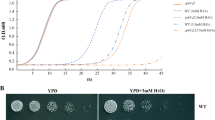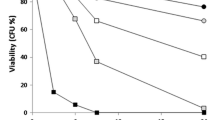Abstract
Eukaryotes employ various mechanisms to survive environmental stress conditions. Multicellular organisms eliminate permanently damaged cells by apoptosis, while unicellular eukaryotes like yeast react by decelerating cell aging. In the present study, transcriptomic and proteomic approaches were employed to elucidate the underlying mechanism of delayed apoptosis. Our findings suggest that Candida tropicalis 3Aer has a set of tightly controlled genes that are activated under Cd+2 exposition. Acute exposure to Cd+2 halts the cell cycle at the G2/M phase checkpoint and activates multiple cytoplasmic proteins that overcome effects of Cd+2-induced reactive oxygen species. Prolonged Cd+2 stress damages DNA and initiates GAPDH amyloid formation. This is the first report that Cd+2 challenge initiates dynamic redistribution of GAPDH and MDH and alters various metabolic pathways including the pentose phosphate pathway. In conclusion, the intracellular redistribution of GAPDH and MDH induced by prolonged cadmium stress modulates various cellular reactions, which facilitate delayed aging in the yeast cell.




Similar content being viewed by others

References
Arshad, M. N., Nisar, M. A., Khurshid, M., Hussain, S. Z., Maqsood, U., Asghar, M. T., & Nazir, J. (2015). Molecular basis of arsenite (As+3)-induced acute cytotoxicity in human cervical epithelial carcinoma cells. Libyan Journal of Medicine, 10, 2015.
Bączek-Kwinta, R., Antonkiewicz, J., Łopata-Stasiak, A., Kępka, W., & A. (2019). Smoke compounds aggravate stress inflicted on Brassica seedlings by unfavourable soil conditions. Photosynthetica, 57, 1–8.
Breitkreutz, A., Choi, H., Sharom, J. R., Boucher, L., Neduva, V., Larsen, B., Lin, Z. Y., Breitkreutz, B. J., Stark, C., Liu, G., Ahn, J., Dewar-Darch, D., Reguly, T., Tang, X., Almeida, R., Qin, Z. S., Pawson, T., Gingras, A. C., Nesvizhskii, A. I., & Tyers, M. (2010). A global protein kinase and phosphatase interaction network in yeast. Science, 328, 1043–1046.
Chemek, M., Boughammoura, S., Mimouna, S. B., Chouchene, L., Banni, M., & Messaoudi, I. (2015). Changes of the mRNA expression pattern of Zn transporters: a probable mechanism for cadmium retention and zinc redistribution in the suckling rat tissues. Biological Trace Element Research, 165, 173–182.
Clark-Adams, C. D., Norris, D., Osley, M. A., Fassler, J. S., & Winston, F. (1988). Changes in histone gene dosage alter transcription in yeast. Genes and Development, 2, 150–159.
Cuddihy, A. R., & O'connell, M. J. (2003). Cell-cycle responses to DNA damage in G2. International Review of Cytology, 222, 99–140.
Discola, K. F., De Oliveira, M. A., Cussiol, J. R. R., Monteiro, G., Bárcena, J. A., Porras, P., Padilla, C. A., Guimarães, B. G., & Netto, L. E. (2009). Structural aspects of the distinct biochemical properties of glutaredoxin 1 and glutaredoxin 2 from Saccharomyces cerevisiae. Journal of Molecular Biology, 385, 889–901.
Draculic, T., Dawes, I. W., & Grant, C. M. (2000). A single glutaredoxin or thioredoxin gene is essential for viability in the yeast Saccharomyces cerevisiae. Molecular Microbiology, 36, 1167–1174.
Elahi, A., & Rehman, A. (2019). Comparative behavior of two gram positive Cr6+ resistant bacterial strains Bacillus aerius S1 and Brevibacterium iodinum S2 under hexavalent chromium stress. Biotechnology Reports, 21, e00307.
Fabrizio, P., Pletcher, S., Minois, N., Vaupel, J., & Longo, V. (2004). Chronological aging independent replicative life span regulation by Msn2/Msn4 and Sod2 in Saccharomyces cerevisiae. FEBS Letters, 557, 136–142.
Falcone, C., & Mazzoni, C. (2016). External and internal triggers of cell death in yeast. Cellular and Molecular Life Sciences, 73, 2237–2250.
Galibert, F., Alexandraki, D., Baur, A., Boles, E., Chalwatzis, N., Chuat, J. C., Coster, F., Cziepluch, C., De Haan, M., Domdey, H., Durand, P., Entian, K. D., Gatius, M., Goffeau, A., Grivell, L. A., Hennemann, A., Herbert, C. J., Heumann, K., Hilger, F., Hollenberg, C. P., Huang, M. E., Jacq, C., Jauniaux, J. C., Katsoulou, C., & Karpfinger-Hartl, L. (1996). Complete nucleotide sequence of Saccharomyces cerevisiae chromosome X. EMBO Journal, 15, 2031–2049.
Gasch, A. P. (2003). The environmental stress response: a common yeast response to diverse environmental stresses. In: Yeast stress responses, (Eds). Springer 11–70.
Gibson, B. R., Lawrence, S. J., Leclaire, J. P., Powell, C. D., & Smart, K. A. (2007). Yeast responses to stresses associated with industrial brewery handling. FEMS Microbiological Review, 31, 535–569.
Goffeau, A., Barrell, B. G., Bussey, H., Davis, R. W., Dujon, B., Feldmann, H., Galibert, F., Hoheisel, J. D., Jacq, C., Johnston, M., Louis, E. J., Mewes, H. W., Murakami, Y., Philippsen, P., Tettelin, H., & Oliver, S. G. (1996). Life with 6000 genes. Science, 274, 563–547.
Gomes, D., Riger, C., Pinto, M., Panek, A., & Eleutherio, E. (2005). Evaluation of the role of Ace1 and Yap1 in cadmium absorption using the eukaryotic cell model Saccharomyces cerevisiae. Environmental Toxicology and Pharmacology, 20, 383–389.
Gourlay, C. W., & Ayscough, K. R. (2005). Identification of an upstream regulatory pathway controlling actin-mediated apoptosis in yeast. Journal of Cell Science, 118, 2119–2132.
Grant, C. M., Luikenhuis, S., Beckhouse, A., Soderbergh, M., & Dawes, I. W. (2000). Differential regulation of glutaredoxin gene expression in response to stress conditions in the yeast Saccharomyces cerevisiae. BBA-Gene Structure and Expression, 1490, 33–42.
Herker, E., Jungwirth, H., Lehmann, K. A., Maldener, C., Fröhlich, K. U., Wissing, S., Büttner, S., Fehr, M., Sigrist, S., & Madeo, F. (2004). Chronological aging leads to apoptosis in yeast. Journal of Cell Biology, 164, 501–507.
Hill, S. M., & Nystrom, T. (2015). The dual role of a yeast metacaspase: What doesn't kill you makes you stronger. BioEssays, 37, 525–531.
Hill, S. M., Hao, X., Liu, B., & Nyström, T. (2014). Life-span extension by a metacaspase in the yeast Saccharomyces cerevisiae. Science, 344, 1389–1392.
Ilyas, S., & Rehman, A. (2018). Metal resistance and uptake by Trichosporon asahii and Pichia kudriavzevii isolated from industrial effluents. Archives of Environmental Protection, 44, 77–84.
Jiang, X., Sun, Q., Li, H., Li, K., & Ren, X. (2014). The role of phosphoglycerate mutase 1 in tumor aerobic glycolysis and its potential therapeutic implications. International Journal of Cancer, 135, 1991–1996.
Jin, Y. H., Clark, A. B., Slebos, R. J., Al-Refai, H., Taylor, J. A., Kunkel, T. A., Resnick, M. A., & Gordenin, D. A. (2003). Cadmium is a mutagen that acts by inhibiting mismatch repair. Nature Genetics, 34, 326–329.
Khan, Z., Hussain, S. Z., Rehman, A., Zulfiqar, S., & Shakoori, A. (2015a). Evaluation of cadmium resistant bacterium, Klebsiella pneumoniae, isolated from industrial wastewater for its potential use to bioremediate environmental cadmium. Pakistan Journal of Zoology, 47, 1533–1543.
Khan, Z., Nisar, M. A., Hussain, S. Z., Arshad, M. N., & Rehman, A. (2015b). Cadmium resistance mechanism in Escherichia coli P4 and its potential use to bioremediate environmental cadmium. Applied Microbiology and Biotechnology, 99, 10745–10757.
Khan, Z., Rehman, A., Nisar, M. A., Zafar, S., Hussain, S. Z., Zerr, I., Hussain, I., Waseem, M., & Arif, M. (2017a). Molecular basis of Cd(+2) stress response in Candida tropicalis. Applied Microbiology and Biotechnology, 101, 7715–7728.
Khan, Z., Rehman, A., Nisar, M. A., Zafar, S., & Zerr, I. (2017b). Biosorption behavior and proteomic analysis of Escherichia coli P4 under cadmium stress. Chemosphere, 174, 136–147.
Kim, S., Cheon, H.-S., Kim, S.-Y., Juhnn, Y.-S., & Kim, Y.-Y. (2013). Cadmium induces neuronal cell death through reactive oxygen species activated by GADD153. BMC Cell Biology, 14, 4.
Kuang, X., Fang, Z., Wang, S., Shi, P., & Huang, Z. (2015). Effects of cadmium on intracellular cation homoeostasis in the yeast Saccharomyces cerevisiae. Toxicology and Environmental Chemistry, 97, 922–930.
Lee, S. M., Kim, J. H., Cho, E. J., & Youn, H. D. (2009). A nucleocytoplasmic malate dehydrogenase regulates p53 transcriptional activity in response to metabolic stress. Cell Death and Differentiation, 16, 738–748.
Li, Z., & Yuan, H. (2006). Characterization of cadmium removal by Rhodotorula sp. Y11. Applied Microbiology and Biotechnology, 73, 458–463.
Longo, V.D., Ellerby, L.M., Bredesen, D.E., Valentine, J.S., & Gralla,, E.B. (1997) Human Bcl-2 reverses survival defects in yeast lacking superoxide dismutase and delays death of wild-type yeast. Journal of Cell Biology, 137, 1581-1588.
Madeo, F., Herker, E., Maldener, C., Wissing, S., Lächelt, S., Herlan, M., Fehr, M., Lauber, K., Sigrist, S. J., Wesselborg, S., & Fröhlich, K. U. (2002). A caspase-related protease regulates apoptosis in yeast. Molecular Cell, 9, 911–917.
Madeo, F., Herker, E., Wissing, S., Jungwirth, H., Eisenberg, T., & Fröhlich, K.-U. (2004). Apoptosis in yeast. Current Opinion in Microbiology, 7, 655–660.
Mandal, D., Bolander, M. E., Mukhopadhyay, D., Sarkar, G., & Mukherjee, P. (2006). The use of microorganisms for the formation of metal nanoparticles and their application. Applied Microbiology and Biotechnology, 69, 485–492.
Meeks-Wagner, D., & Hartwell, L. H. (1986). Normal stoichiometry of histone dimer sets is necessary for high fidelity of mitotic chromosome transmission. Cell, 44, 43–52.
Meunier, B., De Visser, S. P., & Shaik, S. (2004). Mechanism of oxidation reactions catalyzed by cytochrome P450 enzymes. Chemical Reviews, 104, 3947–3980.
O'brien, T., Mandel, H. G., Pritchard, D. E., & Patierno, S. R. (2002). Critical role of chromium (Cr)-DNA interactions in the formation of Cr-induced polymerase arresting lesions. Biochemistry, 41, 12529–12537.
Pai, H. V., Starke, D. W., Lesnefsky, E. J., Hoppel, C. L., & Mieyal, J. J. (2007). What is the functional significance of the unique location of glutaredoxin 1 (GRx1) in the intermembrane space of mitochondria? Antioxidants and Redox Signaling, 9, 2027–2034.
Peeters, K., Van Leemputte, F., Fischer, B., Bonini, B. M., Quezada, H., Tsytlonok, M., Haesen, D., Vanthienen, W., Bernardes, N., Gonzalez-Blas, C. B., Janssens, V., Tompa, P., Versées, W., & Thevelein, J. M. (2017). Fructose-1,6-bisphosphate couples glycolytic flux to activation of Ras. Nature Communications, 8, 922.
Pozniakovsky, A. I., Knorre, D. A., Markova, O. V., Hyman, A. A., Skulachev, V. P., & Severin, F. F. (2005). Role of mitochondria in the pheromone-and amiodarone-induced programmed death of yeast. Journal of Cell Biology, 168, 257–269.
Prado, F., & Aguilera, A. (2005). Partial depletion of histone H4 increases homologous recombination-mediated genetic instability. Molecular and Cellular Biology, 25, 1526–1536.
Ramljak, S., Asif, A. R., Armstrong, V. W., Wrede, A., Groschup, M. H., Buschmann, A., Schulz-Schaeffer, W., Bodemer, W., & Zerr, I. (2008). Physiological role of the cellular prion protein (PrPc): protein profiling study in two cell culture systems. J Proteome Res, 7, 2681–2695.
Rani, A., Kumar, A., Lal, A., & Pant, M. (2014). Cellular mechanisms of cadmium-induced toxicity: a review. International Journal of Environmental Health Research, 24, 378–399.
Rehman, A., & Anjum, M. S. (2011). Multiple metal tolerance and biosorption of cadmium by Candida tropicalis isolated from industrial effluents: glutathione as detoxifying agent. Environmental Monitoring and Assessment, 174, 585–595.
Sastry, M., Ahmad, A., Khan, M. I., & Kumar, R. (2003). Biosynthesis of metal nanoparticles using fungi and actinomycete. Current Science, 85, 162–170.
Saunders, P. A., Chen, R. W., & Chuang, D. M. (1999). Nuclear translocation of glyceraldehyde 3 phosphate dehydrogenase isoforms during neuronal apoptosis. Journal of Neurochemistry, 72, 925–932.
Silva, A., Almeida, B., Sampaio-Marques, B., Reis, M. I., Ohlmeier, S., Rodrigues, F., Vale, A., & Ludovico, P. (2011). Glyceraldehyde-3-phosphate dehydrogenase (GAPDH) is a specific substrate of yeast metacaspase. Biochimica et Biophysica Acta, 1813, 2044–2049.
Walter, D., Wissing, S., Madeo, F., & Fahrenkrog, B. (2006). The inhibitor-of-apoptosis protein Bir1p protects against apoptosis in S. cerevisiae and is a substrate for the yeast homologue of Omi/HtrA2. Journal Cell Science, 119, 1843–1851.
Wang, Y., Fang, J., Leonard, S. S., & Rao, K. M. (2004). Cadmium inhibits the electron transfer chain and induces reactive oxygen species. Free Radical Biology and Medicine, 36, 1434–1443.
Zheng, L., Roeder, R. G., & Luo, Y. (2003). S phase activation of the histone H2B promoter by OCA-S, a coactivator complex that contains GAPDH as a key component. Cell, 114, 255–266.
Acknowledgement
The authors express their gratitude to the Pakistan Science Foundation (PSF), Islamabad-Pakistan for support the present research work under project No. PSF/Res/ Envr (97).
Author information
Authors and Affiliations
Corresponding author
Additional information
Publisher’s note
Springer Nature remains neutral with regard to jurisdictional claims in published maps and institutional affiliations.
Rights and permissions
About this article
Cite this article
Khan, Z., Nisar, M.A., Muzammil, S. et al. Cadmium induces GAPDH- and- MDH mediated delayed cell aging and dysfunction in Candida tropicalis 3Aer. Environ Monit Assess 191, 490 (2019). https://doi.org/10.1007/s10661-019-7631-9
Received:
Accepted:
Published:
DOI: https://doi.org/10.1007/s10661-019-7631-9



